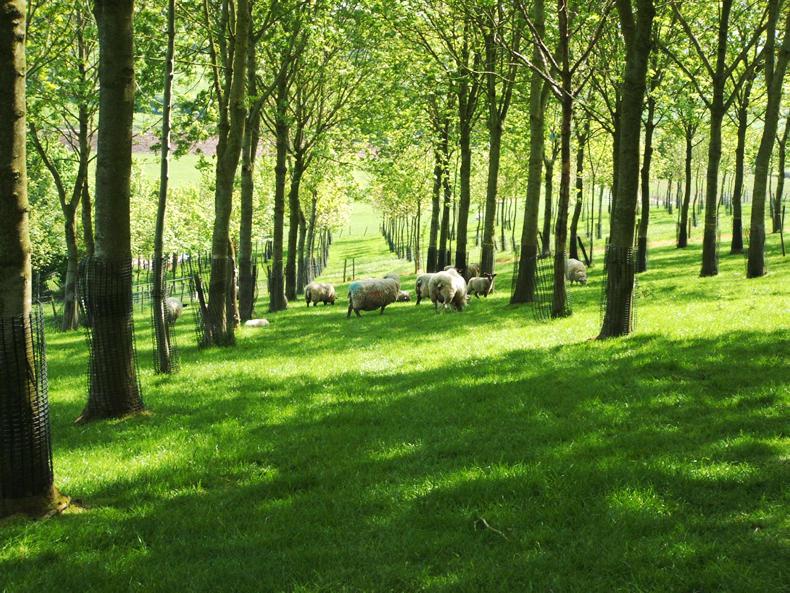Falling forestry plantings pose a risk to Irish agriculture at a time when greenhouse gas emissions must be balanced and the construction industry turns to low-carbon timber materials, speakers told last Thursday’s national forestry conference in Enfield, Co Meath.
“Dairy farmers need you guys in forestry in a way that they probably don’t appreciate,” Teagasc director Gerry Boyle told the conference, pointing out that half of greenhouse gas emissions from agriculture now come from dairy. He showed a picture of ryegrass monoculture as far as the eye can see on one of Teagasc’s own dairy farms: “We must change this to show the sector is serious about climate change and biodiversity,” he said. While taking out trees may have made sense when Ireland joined the EU, Boyle said modern paddock systems can accommodate hedgerows and trees on livestock farms without disrupting production.
Poor afforestation means Ireland is losing out a “triple carbon benefit” from trees, said Marina Conway, chief executive of the Western Forestry Co-op
Irish Farmers Journal editor Justin McCarthy reacted to last week’s historically low afforestation figures by saying that “the farming sector has to look at this as a huge risk. In this scenario, the potential of Irish agriculture will be curtailed in the amount of food we can produce compared to the environmental dividend we deliver.”
Poor afforestation means Ireland is losing out a “triple carbon benefit” from trees, said Marina Conway, chief executive of the Western Forestry Co-op.
Every tonne of timber used instead of cement avoids 2t of carbon dioxide emissions
Not only do they capture carbon dioxide while they grow – they also store it for many years in timber products used in construction, and these displace fossil fuels used in heating or to produce energy-intensive materials such as concrete, steel and aluminium. “Every tonne of timber used instead of cement avoids 2t of carbon dioxide emissions,” she said.
Conway also gave the example of the Aura leisure centre in Carrick-On-Shannon, where the biomass boiler heating the swimming pool and gym uses 500t of pulpwood each year, saving €26,400 in fuel costs and 308t in carbon dioxide emissions.
Coillte’s market development manager Des O’Toole said each timber-frame house locks 19t of carbon into long-term storage.
While the number of timber-frame houses built in Ireland is increasing from 4,600 in 2018 to a projected 5,500 this year, if the total 15,700 houses built annually were all timber frame, this could put away 300,000t of carbon.
Additional potential exists in multi-storey and industrial buildings, engineers and architects said.
O’Toole said Ireland generated under 7% of its heat needs from renewable sources in 2017, well short of the 2020 EU obligation of 12%. Switching 320,000 homes from oil to biomass heating from sources such as wood chips or pellets would be enough to meet this target, he added.
Read more
Scotland shows the way at climate change conference
Forestry planting hits historic low
Falling forestry plantings pose a risk to Irish agriculture at a time when greenhouse gas emissions must be balanced and the construction industry turns to low-carbon timber materials, speakers told last Thursday’s national forestry conference in Enfield, Co Meath.
“Dairy farmers need you guys in forestry in a way that they probably don’t appreciate,” Teagasc director Gerry Boyle told the conference, pointing out that half of greenhouse gas emissions from agriculture now come from dairy. He showed a picture of ryegrass monoculture as far as the eye can see on one of Teagasc’s own dairy farms: “We must change this to show the sector is serious about climate change and biodiversity,” he said. While taking out trees may have made sense when Ireland joined the EU, Boyle said modern paddock systems can accommodate hedgerows and trees on livestock farms without disrupting production.
Poor afforestation means Ireland is losing out a “triple carbon benefit” from trees, said Marina Conway, chief executive of the Western Forestry Co-op
Irish Farmers Journal editor Justin McCarthy reacted to last week’s historically low afforestation figures by saying that “the farming sector has to look at this as a huge risk. In this scenario, the potential of Irish agriculture will be curtailed in the amount of food we can produce compared to the environmental dividend we deliver.”
Poor afforestation means Ireland is losing out a “triple carbon benefit” from trees, said Marina Conway, chief executive of the Western Forestry Co-op.
Every tonne of timber used instead of cement avoids 2t of carbon dioxide emissions
Not only do they capture carbon dioxide while they grow – they also store it for many years in timber products used in construction, and these displace fossil fuels used in heating or to produce energy-intensive materials such as concrete, steel and aluminium. “Every tonne of timber used instead of cement avoids 2t of carbon dioxide emissions,” she said.
Conway also gave the example of the Aura leisure centre in Carrick-On-Shannon, where the biomass boiler heating the swimming pool and gym uses 500t of pulpwood each year, saving €26,400 in fuel costs and 308t in carbon dioxide emissions.
Coillte’s market development manager Des O’Toole said each timber-frame house locks 19t of carbon into long-term storage.
While the number of timber-frame houses built in Ireland is increasing from 4,600 in 2018 to a projected 5,500 this year, if the total 15,700 houses built annually were all timber frame, this could put away 300,000t of carbon.
Additional potential exists in multi-storey and industrial buildings, engineers and architects said.
O’Toole said Ireland generated under 7% of its heat needs from renewable sources in 2017, well short of the 2020 EU obligation of 12%. Switching 320,000 homes from oil to biomass heating from sources such as wood chips or pellets would be enough to meet this target, he added.
Read more
Scotland shows the way at climate change conference
Forestry planting hits historic low






 This is a subscriber-only article
This is a subscriber-only article










SHARING OPTIONS: